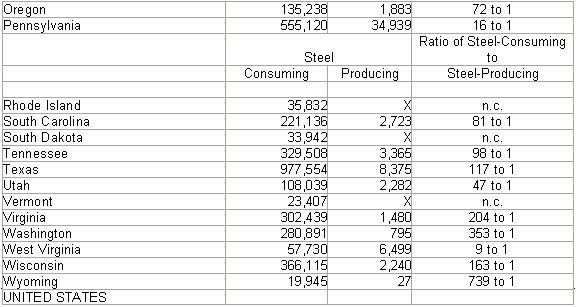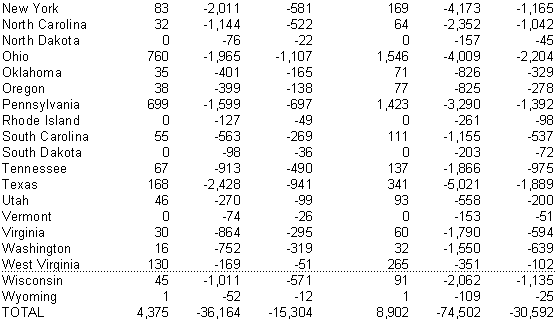|
TESTIMONY OF
Laura M. Baughman
President, Trade Partnership Worldwide, LLC
Before the House Small Business Committee
July 23, 2002
My name is Laura Baughman. I am President of Trade Partnership Worldwide, an economic and trade research firm based in Washington, DC. As an economist I have spent more than 20 years studying and analyzing the dynamics of the U.S. steel industry, and in particular the impact of imports on that industry. I would like to offer you some general information about the American steel-consuming sector to provide context for the company testimony that will follow mine.
Who Are Steel Consumers?
Steel-consuming industries in the United States span a broad range of sectors, including obvious ones like fabricated metal manufacturing, machinery and equipment manufacturing, and transportation equipment and parts manufacturing. These are typically contract manufacturers, producing parts, components and assemblies to customer specifications.
But steel consumers also include chemical manufacturers, who use steel products extensively to store and transport the products they manufacture; petroleum refiners and their contractors who use steel pipe and oil field equipment to drill for and transport petroleum and natural gas; tire manufacturers who put steel belts and cords in tires for safety and durability; and nonresidential construction companies, which use a variety of steel products to build office buildings, bridges, and roads. All these industries need to purchase steel and steel-containing products readily at internationally competitive prices. The ability to do so is crucial to the economic health of these sectors.
The vast majority of steel-consuming manufacturers are small businesses. In fact, 98 percent of all the 193,000 U.S. firms in steel-consuming sectors employ less than 500 workers, according to the Small Business Administration (see Table 1).
These companies have been important to manufacturing job growth in this country over the last 10 years. Between 1995 and 2001, Bureau of Labor Statistics data show that steel-consuming employers added 1,255,000 jobs to the American economy. (During this same period, jobs in the manufacturing sector as a whole declined by 829,000.)
Steel-consuming companies are also an important source of union jobs. Unions represent well over 2.5 million workers in steel-consuming sectors. Union representation ranges as high as 37 percent for some sectors (see Table 2).
Workers in steel-consuming industries vastly outnumber workers employed in the steel industry. Steel-consuming jobs now outnumber steel-producing jobs by 59 to one (1999 data revealed a ratio of 57 to one). While the ratio varies state-by-state, steel-consuming jobs outnumber steel-producing jobs by large multiples in every State (see Table 3).
In short, steel consumers are a vitally important segment of the American economy. Their domestic and international competitiveness should be a concern of policy makers.
What Do Steel Consumers Need to Compete Effectively?
We have over the last year heard a lot about the market dynamics affecting U.S. steel producers. Understanding the current market dynamics that affect the competitiveness of steel-consuming industries is equally essential to making sound policy choices. First, and most fundamentally, American steel-consuming companies and their workers now compete in global markets. The Internet permits steel consumers' customers to shop the world for products designed to their unique specifications. Production can be easily moved to where it makes the most economic sense. Such transfers can take place in a matter of weeks or even days in some cases. Thus, global markets set global prices for products that contain steel.
They Need Steady Steel Supplies
Second, steel consumers must have steady and reliable sources of steel supplies - often on a just-in-time basis - to be competitive. Lead times for steel must be predictable to allow efficient manufacturing operations and on-time deliveries. When steel is not available on schedule, production equipment stands idle, and workers lose earnings. Reliable availability of steel is a necessary precondition for profitability and competitiveness.
They Need to Know What Steel Will Cost
Third, steel consumers need reliable steel price quotes in order to make price quotes of their own, or know that they can meet the terms of pricing contracts that require price reductions. Steel represents 40 to 70 percent of many steel-using manufacturers' costs. Steel consumers cannot operate profitably in a market where steel suppliers tell them they can get them the steel they need, but do not know at the time of the order what it will cost. Clearly, erratically increasing prices of such an important component of production will have serious negative effects on steel-using manufacturers.
Moreover, in most cases, manufacturers of steel parts, components and assemblies for customers in automotive, appliance and other markets are required by their contracts to reduce prices by 1 to 5 percent annually. Failure to meet these terms and conditions means loss of the business. Attached charts show that for at least two very important steel-consuming sectors, machinery and equipment and motor vehicle parts, the prices of the products made from steel have declined steadily since early 1996. Steel suppliers who cannot tell steel consumers what steel will cost, or who break pricing because steel prices are increasingly rapidly, put steel consumers facing declining price contracts in a cost-price squeeze.
They Need Quality Steel
About half the steel sold in the U.S. is purchased by large steel consumers under long-term contracts directly from domestic mills. Smaller steel consumers purchase the other half in the spot market, through steel service centers and other distributors. Service centers typically sell both U.S.-made and foreign steel. Many steel users buy commodity grades of steel. They may not know where the steel came from, nor do they care, as long as they have a steady, reliable supply of competitively-priced steel that meets their and their customer's specifications.
However, many other steel-using manufacturers care enormously where their steel comes from. Their customers demand a very high level of quality and reliability -- dimensional control, mechanical properties or certain safety or performance standards that can only be met by a particular type of steel made by a particular manufacturer, be it domestic or foreign. Some steel consumers work for months, even years, with their customers and with steel producers to help the steel producer pre-qualify to be a supplier for a particular product.
Impact of the Steel Tariffs
Given these fundamental steel-consumer market dynamics, what happened when the President imposed tariffs on steel imports ranging up to 30 percent as a consequence of the Section 201 investigation? As you will hear, steel shortages and massive price increases arose much more quickly than anyone predicted, completely disrupting supply and the ability of steel consumers to control their costs, assure quality, price their products competitively and maintain employment. Competition with foreign manufacturers has intensified, and a growing number of manufacturers have lost business to offshore competition. This trend is likely to continue, and once the business moves offshore, it may be gone forever.
Presently, product exclusions from the tariffs are the only feasible measure of relief available to steel-using manufacturers. Many exclusion requests remain pending, and such exclusions are by no means assured. Domestic steel producers routinely oppose exclusion requests, even for products they do not make or cannot supply.
Not surprisingly, the disruptions in steel availability and price are beginning to have an impact on jobs in steel-consuming sectors. Loss of business to foreign competitors, and/or slowdowns in domestic business because of lack of steel have already begun to reduce hourly paychecks and force some steel-consumers to lay off workers.
Prior to the imposition of the tariffs, the Consuming Industries Trade Action Coalition asked Dr. Joseph Francois and me to evaluate the likely impacts of the tariffs on steel-consuming jobs. Dr. Francois is a professor of economics at Erasmus University, former head of the Office of Economics at the U.S. International Trade Commission, and a managing director of Trade Partnership Worldwide. He is an internationally-recognized expert in modeling the impacts of trade policy proposals, using a model that is highly-regarded and relied upon by the International Trade Commission, the World Trade Organization, the World Bank, the Organization for Economic Cooperation and Development, and the U.S. Department of Agriculture, among others. We evaluated the effects of the ITC's remedy recommendations; the President's selected tariffs fall somewhere in the middle of the ranges we estimated. Our results were consistent with those of the ITC and similar to those of other respected economists analyzing the likely impact of the tariffs on the U.S. economy.
Very briefly, we found that:
- Higher costs of steel inputs and greater competition from imports of steel-containing products resulting from the proposed remedies would lead to a loss (across all sectors in the United States) of between 36,200 and 74,500 jobs. Losses of steel-consuming sector jobs would range from 15,300 to 30,600 (see Tables 4 and 5).
- Under either scenario, eight jobs would be lost for every steel job protected (see Table 4).
- Every state loses out under the proposed remedy recommendations, including states in the "Steel Belt" (see Table 6).
Only time will tell whether these estimates bear out. However, the dramatic price increases steel consumers are already seeing in the market exceed even our estimates, and this does not bode well for the future.
Conclusion
The President's steel decision added formidable import barriers to already substantial barriers caused by antidumping and countervailing duty orders and investigations. These barriers have hurt American steel-using manufacturers badly and will continue to do so as long as they are in effect.
Unfortunately, import barriers are not the appropriate tool to remedy what ails the U.S. steel industry. If they were, 30 years of import protection for steel would have yielded better results. Import restrictions will not make domestic integrated producers more efficient, productive or globally competitive. However, the tariffs are sacrificing the vitality of other sectors of the American economy, sectors that have been, up until now, job generators and heavily dominated by small businesses. They are forcing these businesses to sacrifice what they have built and the jobs they have created. The arithmetic of trade is quite simple. Exports create jobs; so do imports. A strong presence in export markets requires underlying competitiveness, and imports contribute to that competitiveness, both at home and abroad. The steel tariffs are having a distinctly negative impact on the competitiveness, both here and abroad, of a large and important segment of the American economy, steel consumers.

Source: Small Business Administration, Office of Advocacy,
www.sba.gov/advo/stats/us99_n6.pdf

Source: Unpublished data from the Bureau of Labor Statistics.
Table 3
Steel-Consuming Jobs. Vs. Steel-Producing Jobs, 2000


X = The number of jobs is not reported by BLS because the data did not meet confidentiality requirements
n.c. = not calculatable
Source: The Trade Partnership from Bureau of Labor Statistics data.
Table 4
Summary of Results: Estimated Impact of Imposition of Tariffs on U.S. Steel Imports

* Total consumer costs minus benefits to U.S. producers and tariffs collected.
** This includes jobs in agriculture, retailing, services, banking, transportation, the ports, etc., which lose out when income losses in steel-using sectors feed back through the rest of the economy (e.g., reduced spending on food, clothing and shelter from unemployed steel-using sector workers), and when steel-using industries use fewer service inputs.
Source: Trade Partnership Worldwide, LLC, Washington, DC.

* Includes jobs in agriculture, retailing, services, banking, etc., which lose out when income losses in steel-using sectors feed back through the rest of the economy (e.g., reduced spending on food, clothing and shelter from unemployed steel-using sector workers).
Source: Trade Partnership Worldwide, LLC, Washington, DC
 
Source: Trade Partnership Worldwide, LLC, Washington, DC.
|


